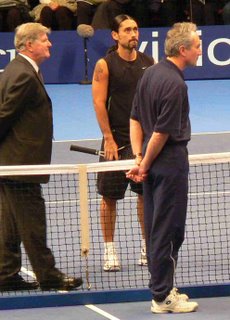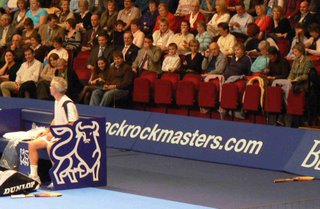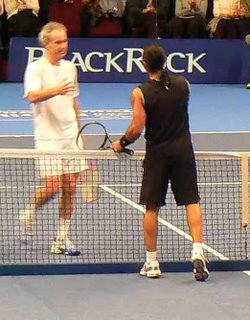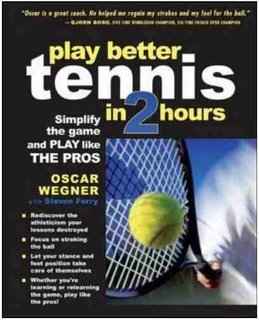Rios v McEnroe
 It was a drizzly and overcast grey day in London on Friday 8th 2006 when, after a lot of press hype about a grudge match and some pre-match sparring between the players, Rios and McEnroe faced off at the Royal Abert Hall in the season ending Blackrock Masters quarter finals. This was the second meeting between the two this year, and had come about with Rios winning his group in the round robin and McEnroe coming second (lucky loser) in his.
It was a drizzly and overcast grey day in London on Friday 8th 2006 when, after a lot of press hype about a grudge match and some pre-match sparring between the players, Rios and McEnroe faced off at the Royal Abert Hall in the season ending Blackrock Masters quarter finals. This was the second meeting between the two this year, and had come about with Rios winning his group in the round robin and McEnroe coming second (lucky loser) in his.The crowd was overwhelmingly in favour of McEnroe, evidenced by the sustained applause he received when walking on court, also on his winning shots, and the numerous shouts of encouragement "come on John". There didn't seem to be a single Rios supporter in the audience, although there was applause for his tennis.
The match started out as a tense affair, with both players trading safe groundstrokes. McEnroe lost his temper quite early when a wide Rios swinging serve to the ad court was called in, whereas McEnroe obviously thought it was out. I was quite surprised over the fuss he made, as I was sitting with a good look down the line and the ball was 'on' the line, and not even close to out.
The first set continued much in the same way with McEnroe losing most of the extended rallies and having only about 50% success on his forays to the net. Either his volleys were short resulting in a successful Rios pass, or Rios won with exquisitely judged lobs. Both players had breaks but it wasn't until Rios came to serve out the first set that he appeared to go up a level in both service and the quality of his shots. It was as if Rios was playing within himself until the time came to close it out.

The second set was slightly more competitive (despite the eventual score), although there were two occasions when theatre intevened. Rios was at one stage unhappy about one of the balls which was eventually replaced by the umpire, and McEnroe had a hissy fit over what he considered to be unfair line calling (of course).
Rios won the second set quite comfortably 6-2. His shot making wasn't awesome, just very controlled, often taking the ball quite early for a winner, his movement and speed were quite good. He didn't use his trademark double handed backhand with both feet off the ground but maybe that's because of the low bounce on a fast court that he had complained about. He also didn't make a single cross court forehand passing shot when pulled out wide to the ad-court side (he's a lefty like McEnroe).
Anyway, although Rios may not be the most charismatic person he let his tennis do the talking. It was difficult to tell his chances of winning the Championship, as his play didn't seem outstanding, doing just enough to win. A test against Haarhuis in the semi-finals will reveal more about his form, and on this court Ivanisevic's serve bombs and serve volley game might be too much if they both get to the final.
Update: Haarhuis beat Rios and faces Ivanisevic in the final.




